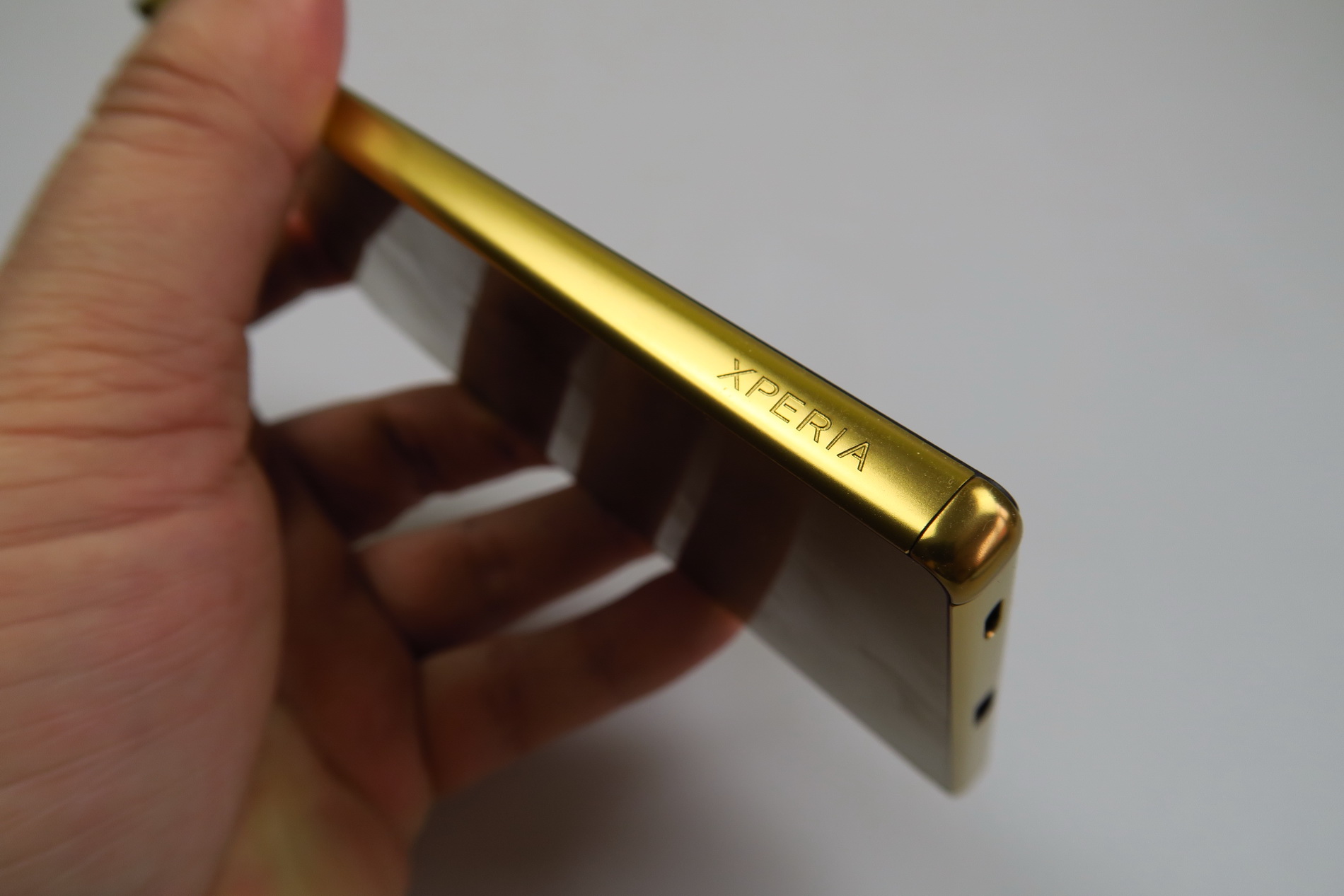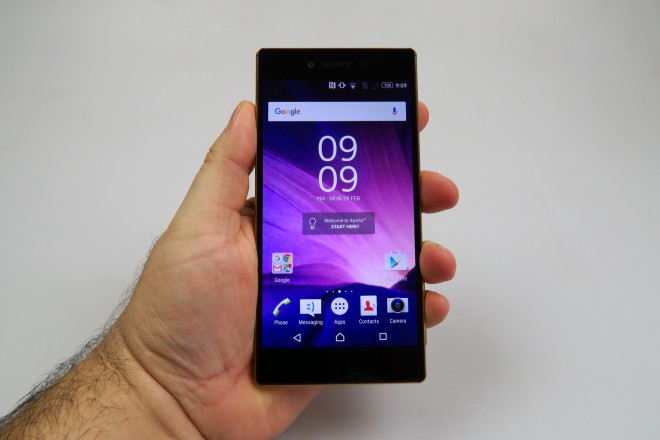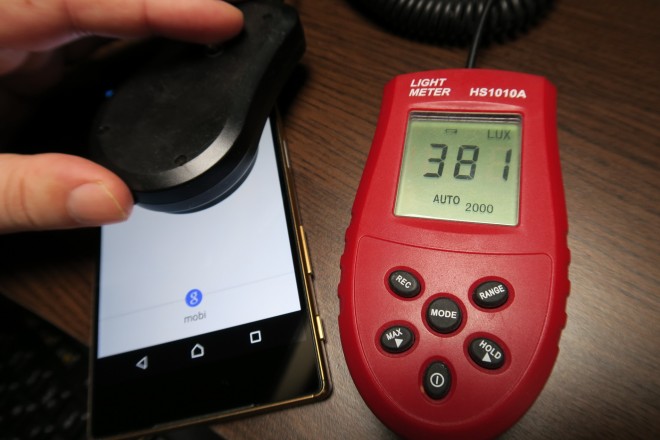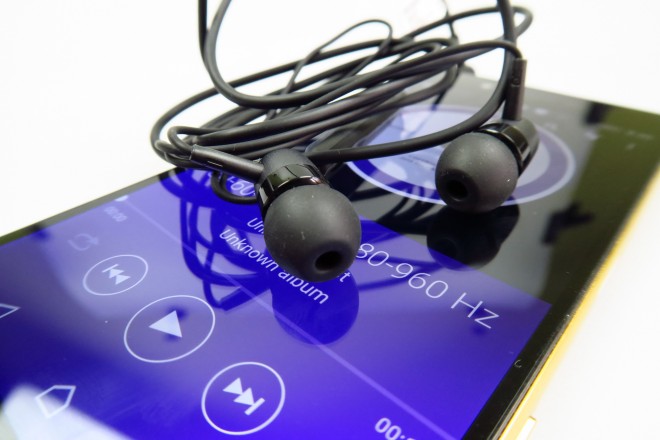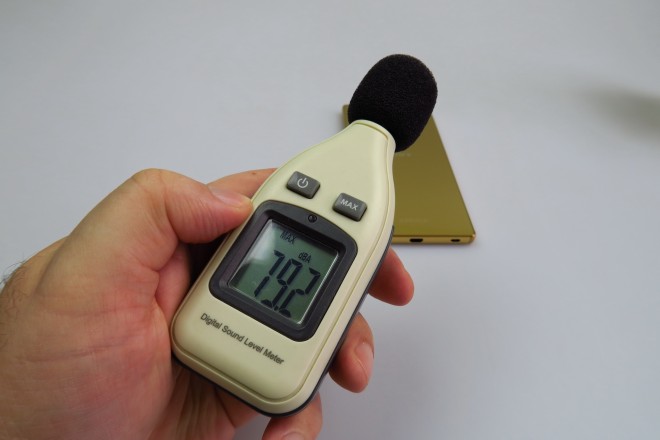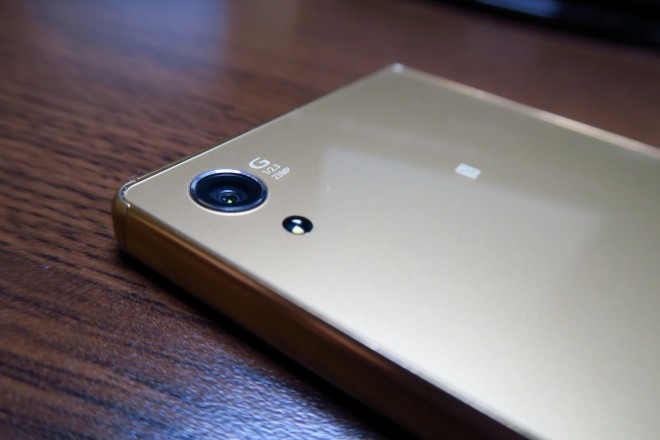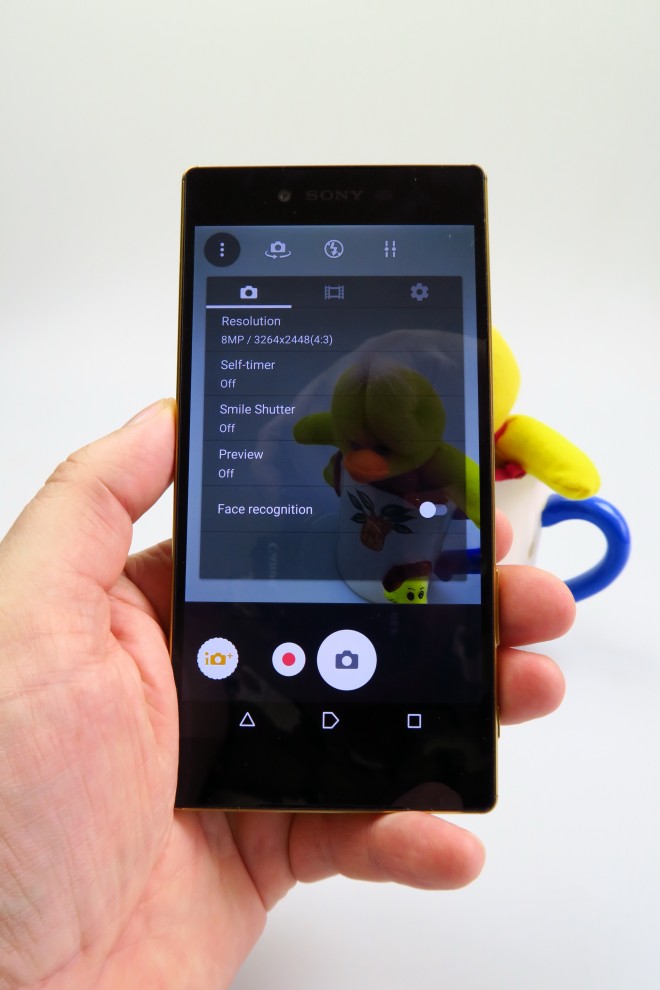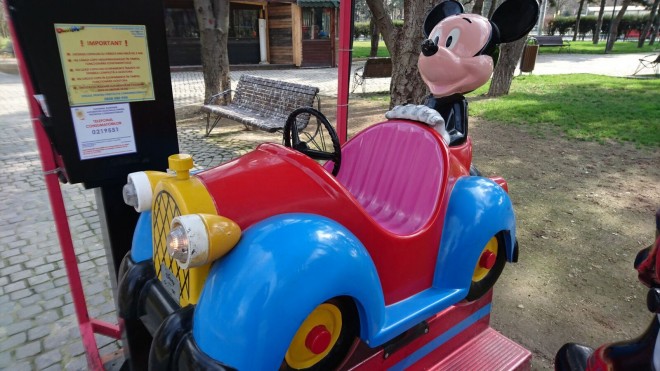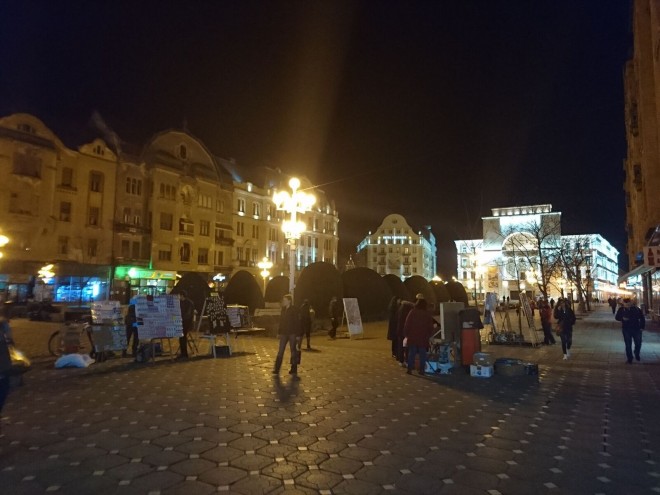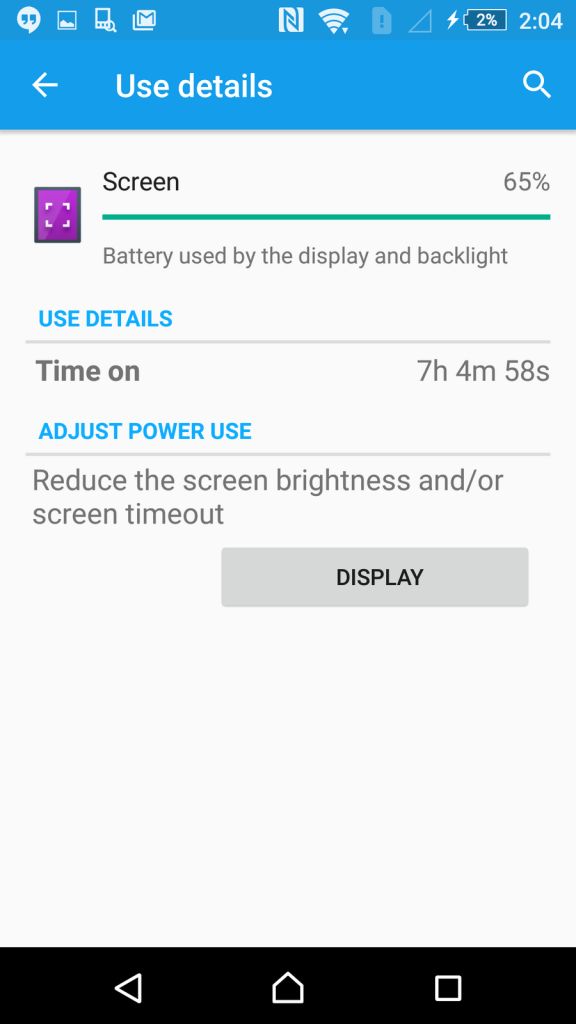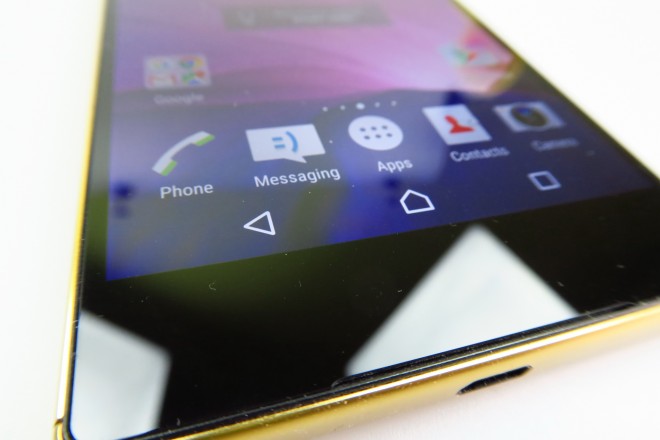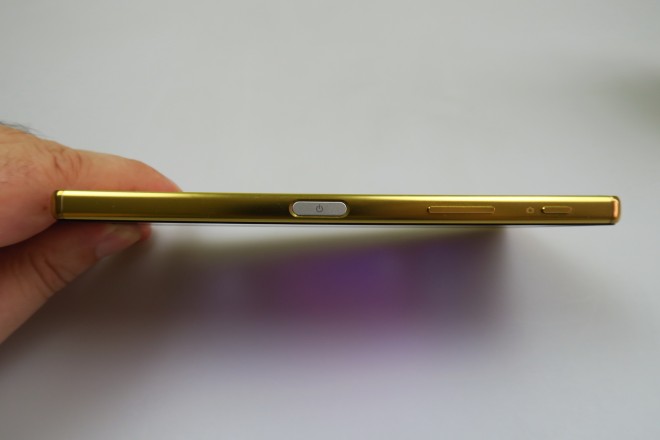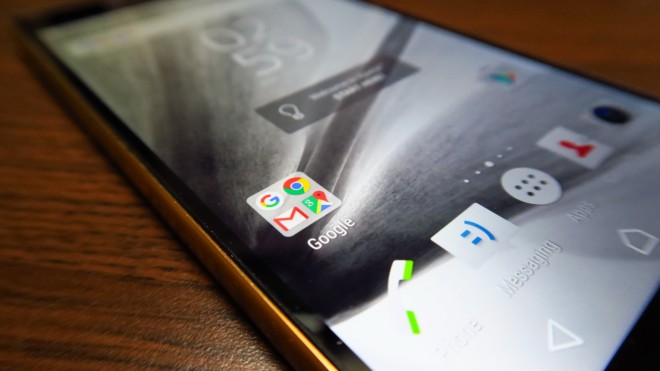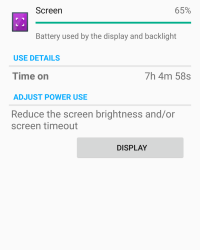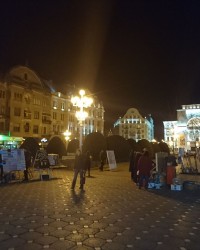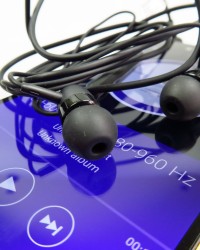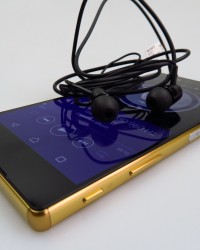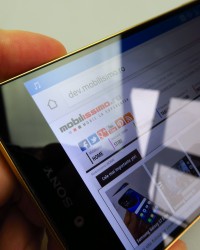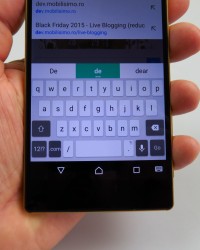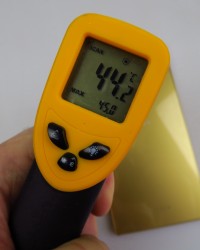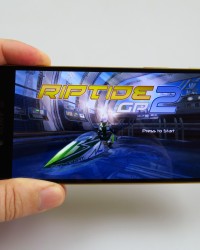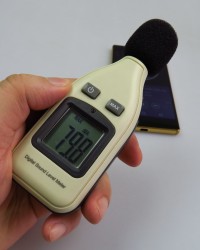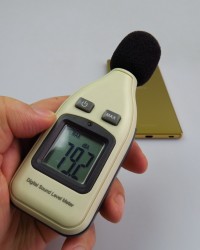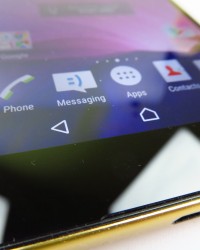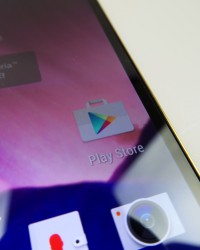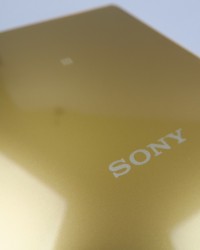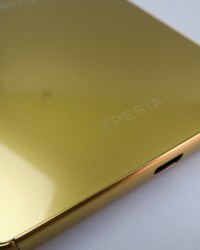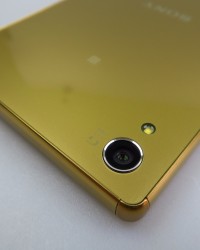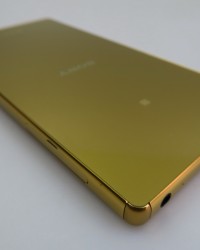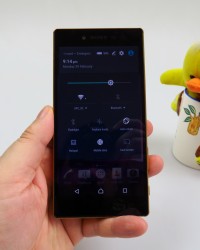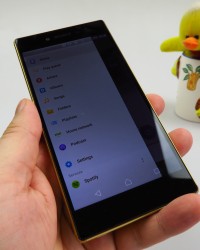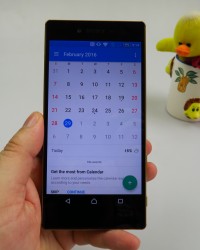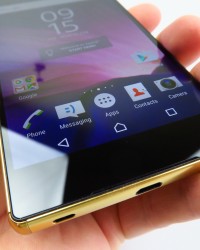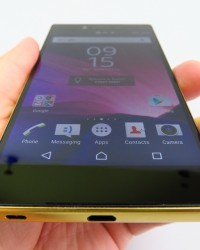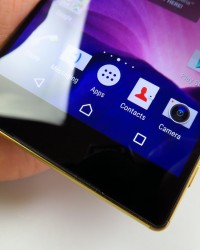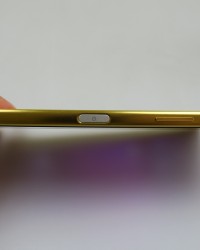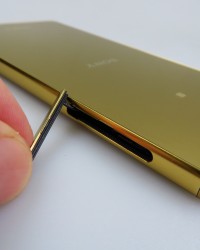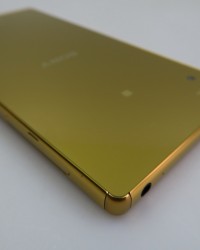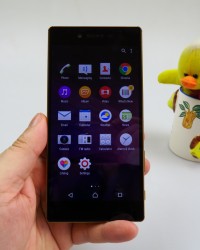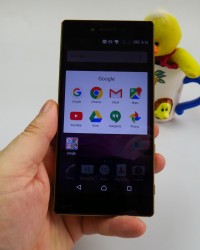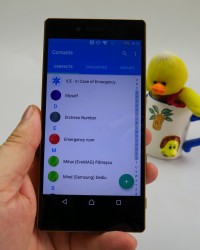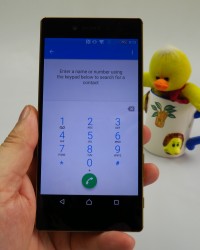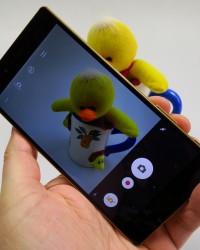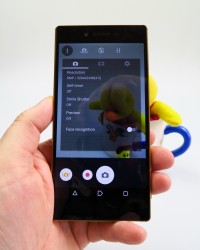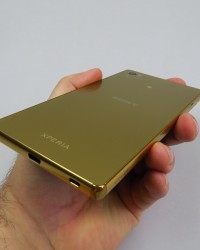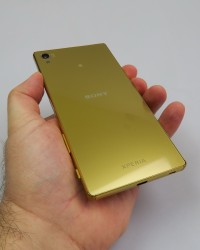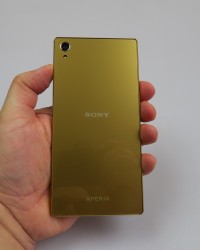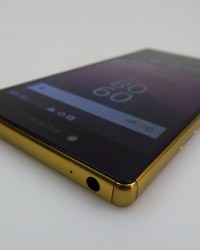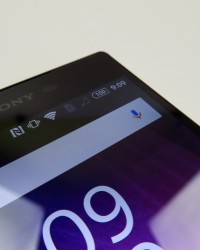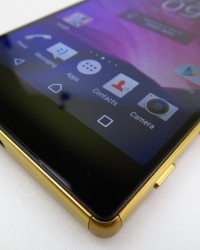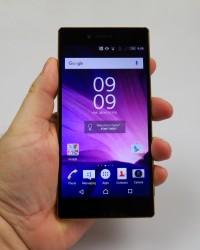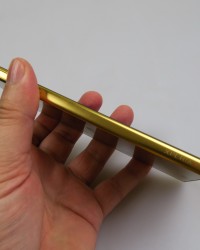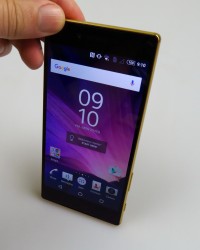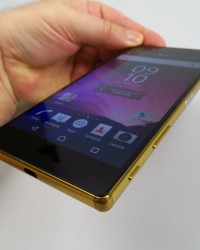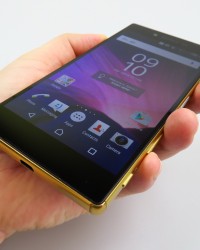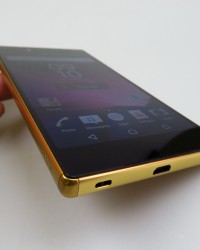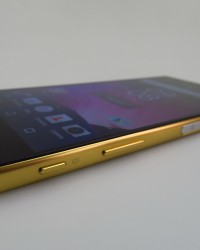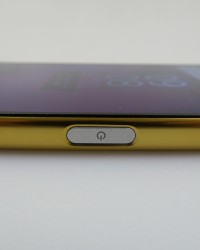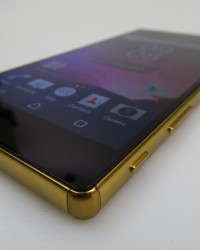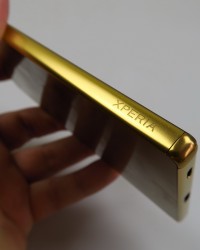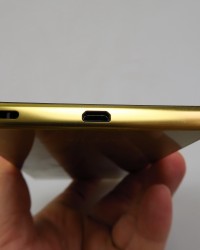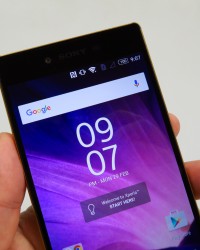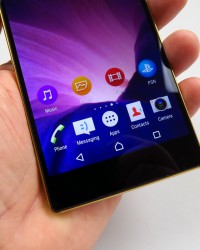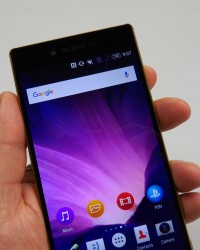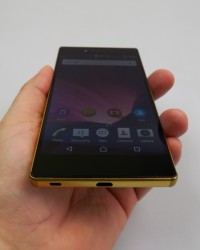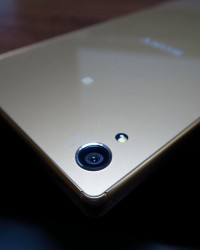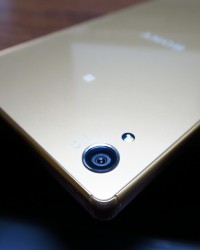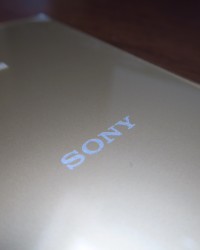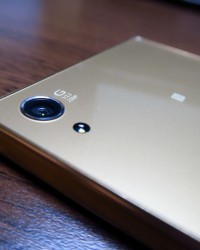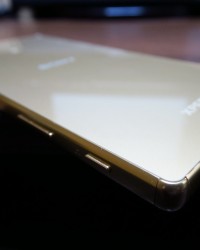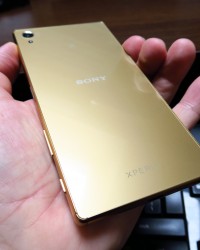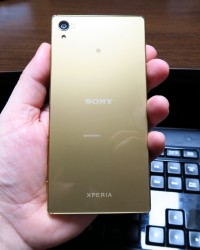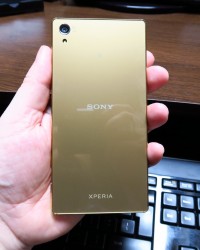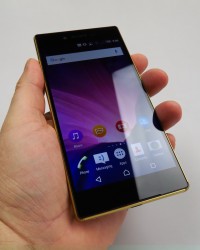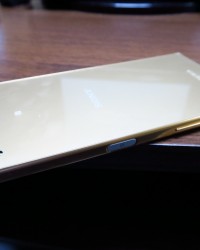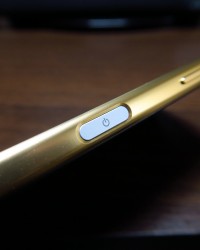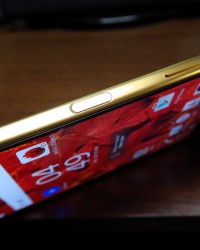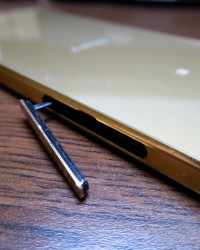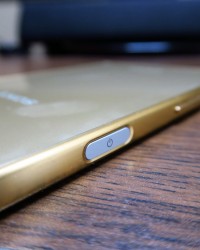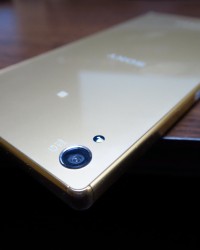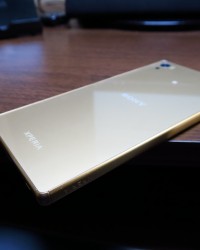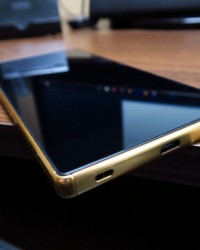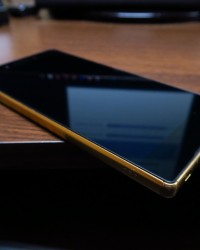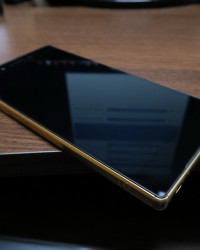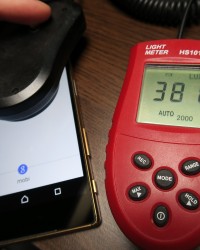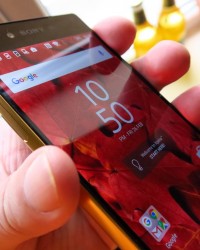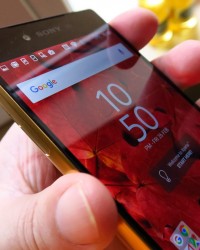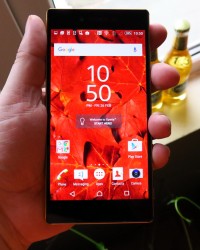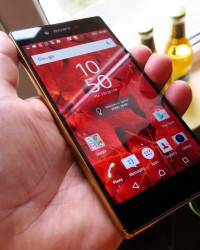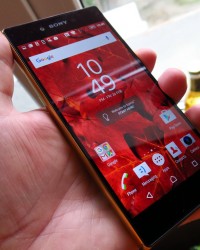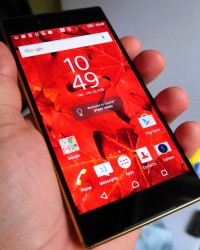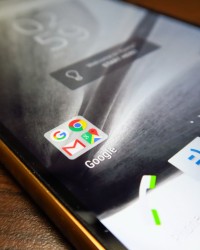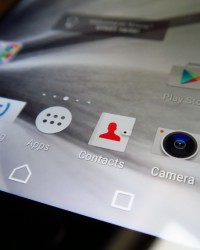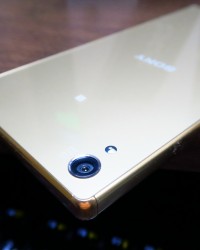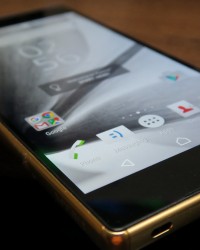Sony launched a trio of devices last fall, at IFA 2015 and the highest end device within the trio was the Sony Xperia Z5 Premium. The device is the very first 4K display smartphone on the market and the first 4K mobile device we test. Priced at $620 on Amazon, this model is one of the few risks that Sony took over the past years and now let’s see if this is a winning bet.
We’re dealing with a 5.5 inch handset, that measures 7.8 mm in thickness and weighs 181 grams. This means it’s 0.5 mm thicker than the iPhone 6S Plus, but also 11 grams lighter. It looks like a gold bar and it’s quite a long phone, also quite massive and slippery. One hand usage is out of the question, but this remains an elegant piece of work. It’s 30 grams heavier than the Sony Xperia Z5 and it comes with a metal frame and a reflective glass back.
Not a huge deal has changed since the days of the Sony Xperia Z3 and Z4 and we still get the reinforced corners, useful in case of drops on the floor. We’ve got an atypical placement of the volume buttons, much lower than usual and hard to reach in my view. We also get a camera button on the same side. This is a dust and water proof device, certainly unique and elegant, but heavy and slippery.
Moving on to the hardware, we find the display, a 5.5 incher with an IPS LCD panel and a 3840 x 2160 pixel resolution, which is 4K. Most of the time we see Full HD images on this screen, for example in the main UI and the only time we can actually see 4K content is in the Album and Video app, or Netlfix and YouTube, provided said content is in 4K.
Frankly speaking, I couldn’t notice the jump from Quad HD to 4K with the naked eye and probably nobody did. The actual viewing experience was very crisp, as if the image were flowing from the screen. Colors are great, there’s no oversaturation and brightness is OK at first sight. View angles aren’t very wide and the display behaves poorly in sunlight, so contrast isn’t top notch.
Pixels are of the RGB Stripe kind and the brightness level we measured was 381 LUX, which is not very impressive. We’re even below the Sony Xperia Z3, that scored 401 LUX and below the OnePlus One, that reached 404 LUX. In the Settings area you can set up the Super Vivid Mode, X Reality and adjust white balance, but in the end the result is the same: contrast and brightness are unimpressive.
Frankly I also can’t see the benefits of 4K, but this is a bold experiment from Sony. Now let’s talk the other hardware, starting with the Qualcomm Snapdragon 810 processor, the octa core model that defined the year 2015, comprised of 4 cores at 1.5 GHz and 4 cores at 2 GHz. Other specs include 3 GB of RAM, 32 GB of storage and a microSD card slot with support for up to 200 GB.
The device doesn’t have any lag and it comes with a fluid UI, plus it can run any game you throw at it, from Asphalt 8 to FIFA 16 and any shooter you can imagine. Sadly, the handset suffers from serious overheating, reaching 45 degrees Celsius after playing the game Riptide GP2 for 15 minutes, which is a huge value.
In benchmarks we fought the likes of the Galaxy S6 in Quadrant and won, while the Galaxy S6 Edge+ was surpassed in 3DMark Unlimited. HTC One M9 was beaten in AnTuTu, so overall performance was good. On the audio front, there are dual front speakers here and a confusing music player, with a ton of options to the left side.
You can upgrade any tune to high resolution music, courtesy of the DSEE HX feature. The acoustic experience involves an OK clarity, good bass and a rather modest volume. Headphones are comfy and loud, offer a great bass and excellent noise isolation. We tested the device’s sound strength using a decibelmeter and got up to a value of 79.8 dBa upfront, which is quite weak, considering the Xperia Z3 got up to 84.1 dBA.
There’s also FM Radio in the mix and frankly I expected more here. There are tons of options related to bass, surround and what have you, but those don’t quite help. As far as the camera goes, there’s a 23 megapixel shooter at the back, with a 1/2.3 inch sensor size and hybrid autofocus in 0.03 seconds, as well as up to 8X digital zoom.
There’s no optical image stabilization, so we have to do with the Steadyshot technology instead. The camera app starts up fast and it’s now more intuitive following a software update. It’s based on swipes to alternate between the various capture modes, including Superior Auto, a series of apps (more downloadable), Manual and Video.
Focus is very fast and so is picture taking. Among the many camera apps we find Stickers, 4K video capture, augmented reality features and ways to take shots with both the front and back camera at the same time. The gallery of shots we took includes great closeups and realistic colors. We were happy with the focus and we registered good texture in the shots we took.
Selfies didn’t quite impress, but that ice cream texture, color and exposure were excellent. I’d say this camera is on par with the Samsung Galaxy S6 or the LG G4 sensor. It clearly beats the iPhones on account of the quantity of details. Landscape shots have excellent details, although we did have the odd blurred background shot here and there. Closeups remain the strong suit of the camera, as well as the quality and details of the shots.
White balance and exposure weren’t half bad, even when the sun got into the clouds. Then we got to low light photo capture (gallery) and found the flash to be excellent, but overall the images had a blue-ish hue to them that I didn’t quite fancy. The shots were pretty bright and the colors were OK. I have to say that the level of grain here was unimpressive and compared to the best Huawei phones for example, like the Mate 8, the Xperia Z5 Premium pales.
It also seems that the camera can’t face the street lights properly, so the halos are not pleasing to the eye. I’d say that there were too many shots for this handset to qualify as fit for low light capture. It’s also inferior to the LG G4 and some 2015 flagships. Video is shot in 4K or Full HD at 60 or 30 FPS, in MP4 format.
The clips were shaky, a bit burnt, but the clarity is OK and stabilization is great, courtesy of SteadyShot. The 60 FPS clips looked great, but I noticed that usually video captures were burnt around the edges. There’s no refocusing and colors were excellent. You should try and avoid exposing the camera to too much sun, otherwise the video capture will suffer.
Although I was pleased with the video capture, when it came to low light filming, things were very poor. There are yellowish hues and a blue-ish filter of sorts that muddies the quality. Overall, the Sony Xperia Z5 Premium films better than the LG G4 during the day and many other models, perhaps even the iPhones, but during the night it’s no match to any of them.
Stabilization is also something to notice here. The browser of choice here is Chrome, that is kind of slow, but registers OK results in Sunspider, Vellamo and BrowserMark. The keyboard is comfy and it’s very well spaced. When it comes to connectivity, you should know that we tested the dual SIM version of the smartphone, that uses nano SIM Slots.
This model supports LTE Category 6, has GPS, Bluetooth 4.1, DLNA, MHL 3.0, NFC and WiFi with MIMO. Xperia Z5 Premium offers loud calls, with crisp sound, plus they’re very clear and signal is also good. Noise cancelling is pretty much perfect and WiFi testing showed us a speed of 26 Mbps in download and 27 Mbps in upload, which is also great.
Now let’s analyze the battery, a 3430 mAh unit, that on paper provides 2 days of usage, according to Sony. In our HD video playback test, we achieved 7 hours and 5 minutes, which is very weak for a phablet, even being below the entry level model Xperia E4 and the Amazon Fire Phone. In PCMark we got to 5 hours and 19 minutes, which is also weak and below the Huawei P8 and Xperia E4.
Finally, charging takes 2 hours and 34 minutes, which is reasonable, but not impressive. Then there’s the Stamina Mode and Ultra Stamina for power saving saving, but I must caution you, that these features disappear with the Marshmallow update. And now we have reached the software area, where we find the Android 5.1.1 Lollipop OS with the Xperia skin on top.
It’s a glossy UI, pleasing to the eye, with lots of transparency and no useless contours. Widgets are beautiful and the experience is cohesive with other Sony products, PlayStation included. Multitasking is based on a carousel and also includes a floating apps section, for an extra layer of multitasking. The dropdown section is the stock one and aside from the pretty widgets, we’ve also got pretty themes.
We tested the fingerprint scanner integrated within the Power button and found that the setup was rather long, but the sensor was accurate and comfy. Placement is quite smart. Having counted the preinstalled apps, we came up to 46, pretty close to bloatware level. Among these apps we found interesting Lifelog, that serves to monitor your actions and I mean everything, from how much video you watch, to how much gaming you do, sports, sleep and everything else.
There’s also a Movie Creator, Sketch and Track ID, plus Spotify. And now it’s guess it’s time for the verdict. Let’s see the Pros and Cons!
These are the Pros:
elegant and solid device
crisp screen image
great colors
no lag
good performance
great pictures during the day
great stabilization even without OIS
nice UI
comfy fingerprint scanner
And the Cons:
slippery
low brightness
overheats badly
low volume
mediocre selfies
poor low light capture
poor battery
poor view angles
In the end, the Sony Xperia Z5 Premium has the great looks and the camera, plus performance on its side, but problems like overheating and screen brightness drag back an otherwise appealing package. It’s like Sony is taking one step forward and two back, as they’ve done every time for the past years. It’s still a very solid phone for Sony aficionados. Its latest price is here.

